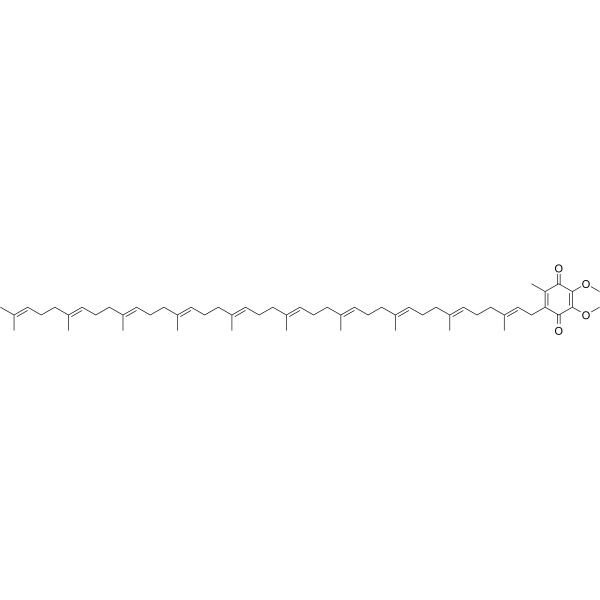天然产物醌类Quinones
Coenzyme Q10 (Synonyms: 辅酶Q10; CoQ10; Ubiquinone-10) 纯度: ≥98.0%
Coenzyme Q10是电子传递链的重要辅助因子,也是一种有效的抗氧化剂。

Coenzyme Q10 Chemical Structure
CAS No. : 303-98-0
| 规格 | 价格 | 是否有货 | 数量 |
|---|---|---|---|
| Free Sample (0.1-0.5 mg) | Apply now | ||
| 100 mg | ¥450 | In-stock | |
| 200 mg | ¥650 | In-stock | |
| 500 mg | 询价 | ||
| 1 g | 询价 |
* Please select Quantity before adding items.
Coenzyme Q10 相关产品
•相关化合物库:
- Natural Product Library Plus
- Drug Repurposing Compound Library Plus
- FDA-Approved Drug Library Plus
- Bioactive Compound Library Plus
| 生物活性 |
Coenzyme Q10 is an essential cofactor of the electron transport chain and a potent antioxidant agent. |
||||||||||||||||
|---|---|---|---|---|---|---|---|---|---|---|---|---|---|---|---|---|---|
| IC50 & Target |
|
||||||||||||||||
| 体外研究 (In Vitro) |
Coenzyme Q10 is an obligatory member of the respiratory chain in the mitochondria of all cells. Therefore, it is an essential ingredient in the formation of adenosine triphosphate (ATP), the source of energy in most cellular processes. Coenzyme Q10 is located in the mitochondria, lysosomes, and Golgi and plasma membranes, and provides an antioxidant action either by direct reaction with free radicals or by regeneration of tocopherol and ascorbate from their oxidised state[1]. Coenzyme Q10 is a popular dietary supplement because of its recognition by the public as an important nutrient in supporting human health. The rationale for the use of Coenzyme Q10 as a therapeutic agent in several cardiovascular and degenerative neurologic and neuromuscular diseases is based upon its fundamental role in mitochondrial function and cellular bioenergetics[2]. Shanghai Jinpan Biotech Co Ltd has not independently confirmed the accuracy of these methods. They are for reference only. |
||||||||||||||||
| 体内研究 (In Vivo) |
Because of its hydrophobicity and large molecular weight, absorption of dietary Coenzyme Q10 is slow and limited. In the case of dietary supplements, solubilized Coenzyme Q10 formulations show enhanced bioavailability. The Tmax is around 6 h, with an elimination half-life of about 33 h. The reference intervals for plasma Coenzyme Q10 range from 0.40 to 1.91 mM in healthy subjects. With Coenzyme Q10 supplements there is reasonable correlation between increase in plasma Coenzyme Q10 and ingested dose up to a certain point. Animal data show that Coenzyme Q10 in large doses is taken up by all tissues including heart and brain mitochondria[2]. In 12-month-old rats administration of coenzyme Q10 results in significant increases in cerebral cortex mitochondrial concentrations of coenzyme Q10. Oral administration of coenzyme Q10 markedly attenuates striatal lesions produced by systemic administration of 3-nitropropionic acid and significantly increases life span in a transgenic mouse model of familial amyotrophic lateral sclerosis[3]. Shanghai Jinpan Biotech Co Ltd has not independently confirmed the accuracy of these methods. They are for reference only. |
||||||||||||||||
| Clinical Trial |
|
||||||||||||||||
| 分子量 |
863.34 |
||||||||||||||||
| Formula |
C59H90O4 |
||||||||||||||||
| CAS 号 |
303-98-0 |
||||||||||||||||
| 中文名称 |
辅酶Q10 |
||||||||||||||||
| 运输条件 |
Room temperature in continental US; may vary elsewhere. |
||||||||||||||||
| 储存方式 |
-20°C, sealed storage, away from moisture and light *该产品在溶液状态不稳定,建议您现用现配,即刻使用。 |
||||||||||||||||
| 溶解性数据 |
In Vitro:
DMF : 40 mg/mL (46.33 mM; Need ultrasonic) Ethanol : 2.5 mg/mL (2.90 mM; Need ultrasonic) H2O : < 0.1 mg/mL (insoluble) DMSO : < 1 mg/mL (insoluble or slightly soluble) 配制储备液
*
请根据产品在不同溶剂中的溶解度,选择合适的溶剂配制储备液;该产品在溶液状态不稳定,建议您现用现配,即刻使用。 In Vivo:
请根据您的实验动物和给药方式选择适当的溶解方案。以下溶解方案都请先按照 In Vitro 方式配制澄清的储备液,再依次添加助溶剂: ——为保证实验结果的可靠性,澄清的储备液可以根据储存条件,适当保存;体内实验的工作液,建议您现用现配,当天使用; 以下溶剂前显示的百
*以上所有助溶剂都可在 Shanghai Jinpan Biotech Co Ltd 网站选购。
|
||||||||||||||||
| 参考文献 |
|
| Animal Administration [3] |
Rats[3] The effects of oral administration of coenzyme Q10 on 3-NP-induced striatal lesions are examined in 300- to 350-g rats (n=5-10). Animals receive either rat chow supplemented with coenzyme Q10 at 200 mg/kg or unsupplemented rat chow. After 1 week they are treated with 3-NP at a dose of 10 mgykg i.p. twice a day until either a control or treated animal became symptomatic with hindlimb dystonia, and then sacrificed in pairs[3]. Mice[3] To determine whether coenzyme Q10 exerts neuroprotective effects in a transgenic mouse model of a human neurodegenerative disorder, coenzyme Q10 (200 mg/kg) is administered orally to 16 transgenic mice overexpressing a human CuyZn superoxide dismutase (SOD1) mutation, as compared with 13 animals that receive unsupplemented rat chow. The mice used are the G1 line, which expresses high levels of human SOD with the G93A mutation. Treatment is started at 50 days after birth. Treatment is continued until mice reach end-stage disease[3]. Shanghai Jinpan Biotech Co Ltd has not independently confirmed the accuracy of these methods. They are for reference only. |
|---|---|
| 参考文献 |
|
